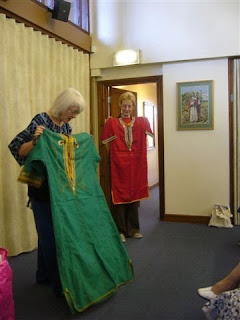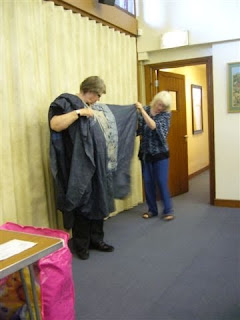Maggie brought a sales table full of enticing African fabrics, beads, kits and much more. She also brought vintage and modern African clothing, ranging from special occasion wear to everyday outfits. She finished her talk by showing us a pair of sandals made from car tyres – they weren’t comfortable but they showed the resourcefulness of the African people.
Dorothy models a man’s garment made from a single piece of cloth. Such voluminous outfits made from heavy damask and beautiful embroidery were not intended for comfort but to demonstrate the owner’s wealth and importance.
Maggie and Elaine hold up two North African kaftans.
Maggie holds the top of a formal Moroccan man’s outfit while Norma has the bottom half! Made from damask cloth, it is embellished with Cornelli chain stitch embroidery
Maggie holds the top of a formal Moroccan man’s outfit while Norma has the bottom half! Made from damask cloth, it is embellished with Cornelli chain stitch embroidery
Carole’s garment would be worn by a Muslim and therefore would be accompanied by a hat like this one. The hat’s embroidery would have been stitched by a man.
Dorothy and Betty wear modern smocks from North Ghana , each weighing about 2 kgs. The cream one is hand spun cloth. The construction method for each is different and quite complex. Maggie told us that a person would buy a smock in the market then take it to an embroiderer to be personalised.
Hilary and Maggie show off a patchwork suit made from tailors’ offcuts. These cheap garments would be given to religious people who live without money.
Wendy – Pat Milius’s daughter-in-law from New Zealand
Dorothy’s outfit from West Africa shows the skill of the tailor. He has used the printed pattern of the cloth to make a feature on the fitted sleeveless bodice. As well as the top and skirt, the outfit includes a length of cloth for the owner to wrap around her when sitting on public transport or on a bench, to keep the skirt clean.
An extremely interesting and informative meeting!









No comments:
Post a Comment